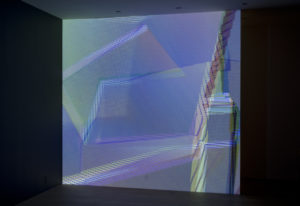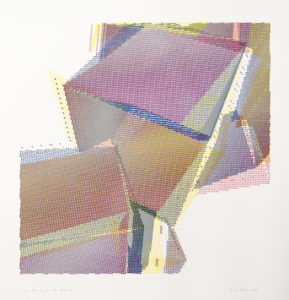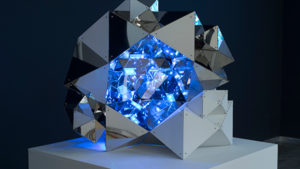Casey calls himself an educator and an artist. As an educator, he is a professor at UCLA in the Department of Design Media Arts. He also co-created the Processing language with Ben Fry, which can be considered as one his biggest accomplishments.
He has a lot of accomplishments as an artist as well, having his work shown in various major museums like the Whitney Museum. Casey explores with various different forms of art, such as prints, installations, software.. etc.

This is one of his recent works, called Still Life (2016). This is a custom created software, that was then installed in a gallery in New York City. The images change throughout the time, and it gives off a very trippy yet peaceful vibe. To watch how this installation looks like when it’s active, here is a link to the video that was captured of the actual installation in the gallery: http://reas.com/still_life_rgb_av_a/
There are three different types in his Still Life series, one having sound, and the others being silent. I believe that two silent Still Life installations were projected next to each other, while the one with sound was projected independently, and larger, for emphasis.

This is one of his prints, called RGB-056-006-080-823-715. This is similar to his installation showed earlier, using different color dashes. I think the name of this work is very interesting, he probably has many different versions that are slightly different with different numbers in their names. There is something very similar to this on his website with colors being black and white.

This is one of his physical installations, that was showed in the gallery in New York. It is calledPrimitives (This Could be an Extraordinary Find). I personally enjoy this one a lot, it blinks and lights up in blue. This is the link to the video to see installation in action: http://reas.com/primitives/
Casey collaborated with Aranda\Lasch for this project, for help in creating the physical form of his works.
I find Casey’s works very fascinating, and I love how he explores with different forms of art.

Great post Leah! It’s really interesting to learn about one of the co-creators of the language we use in class. It would be great to find out more about his process when creating his prints or installations.
I really liked the post! I watched both the videos and in the first video I found it interesting that the sound tunes out the outside world and the soothing nature of the visual; Reas creates a very relaxed and peaceful atmosphere that really captures one’s attention. I liked how his instillation was both minimalist and detailed; it would be interesting to learn more about his process and what his motivations and inspirations are.
This post is amazing! I thought it very cool that most of his work seems to follow a prismatic structure almost as if you were looking through a kaleidoscope and focusing on one specific point. I was wondering if you had any information on the nature of how he came up with his style?
Awesome post! I really like the atmosphere ans style that Reas creates. I wonder how the sound in his piece was created?
Still Life is fascinating. I would like to actually be in that space and feel the peaceful yet eerie atmosphere. Visualization of sound seems to be something Processing can be really good at. It will be really cool to look into the process of creating generative art that responds to a sound.
Casey’s work is really exciting. He’s one of the people who straddles both the world of art and computation exceptionally well. As he said in the video you all watched in week 2, he often produces still images from Processing that he makes prints of. It’s really interesting to see the evolution of his output over the years, moving from this : http://www.bitforms.com/reas/path-03 to this : http://www.bitforms.com/reas/still-life-rgb-b He’s represented by bitforms gallery in NYC which shows his work sometimes. You should check it out.
Really cool post! I really like Reas’ artworks’ vibes; super cool how he’s able to make a holographic texture with code. It would be interesting to hear what his process is like.
This artwork is super interesting, and I can see why you chose it! I’m curious about the abstract nature of the pieces and am wondering if the same coding methods could be used to create something more representational.
The artwork is very beautiful and modern. I really like the 3d renderings and boxy/edgy style he has. It makes a 2d panel really pop.All of his art seems to show texture and looks like real artwork someone painted. His sculptures are pretty cool too and follow the same flow of his processing art.